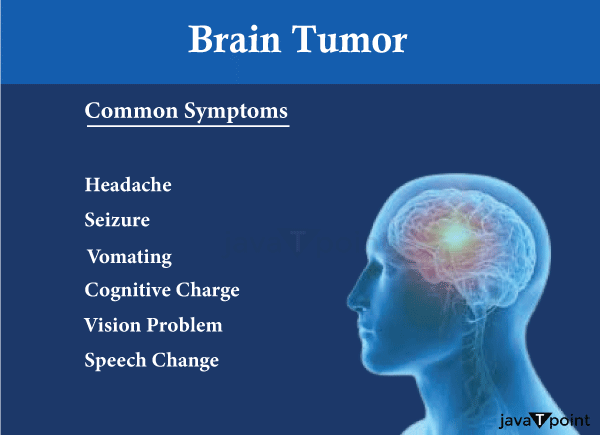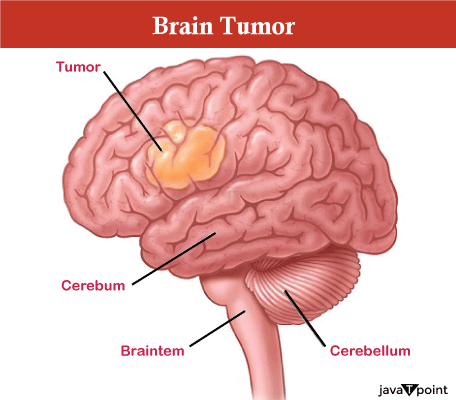Brain Cancer SymptomsWhen aberrant cells grow in the brain, a tumor is a result. Tumors may be classified into two categories: malignant and benign (non-cancerous). These may also be divided into two categories: primary tumors, which originate within the brain, and secondary tumors, or brain metastasis tumors, which often have spread from tumors outside the brain. Depending on the tumor's size and the section of the brain it affects, symptoms from all sorts of brain tumors might differ. Where symptoms are present, they may include migraines, convulsions, visual issues, vomiting, and mental disturbances. Other symptoms include the inability to talk, move, feel things, or be unconscious. 
Up to 4% of brain malignancies may be attributed to radiation from CT scans. However, the majority of brain tumors have no recognized cause. Exposure to vinyl chloride, the Epstein-Barr virus, ionizing radiation, and genetic diseases such as neurofibromatosis, tuberous sclerosis, and von Hippel-Lindau are uncommon risk factors. Studies on the use of mobile phones have not shown any obvious risks. Meningiomas are often benign, and astrocytomas, such as glioblastomas, are adults' most prevalent primary tumor forms. Malignant medulloblastoma is the most prevalent form in youngsters. Computed tomography (CT) or magnetic resonance imaging (MRI) is often used in conjunction with a medical examination to make a diagnosis. The outcome is then often verified by a biopsy. The tumors are categorized into several severity levels based on the results. Surgery, radiation therapy, and chemotherapy are all possible treatment options. Anticonvulsant drugs may be required if seizures occur. Drugs like dexamethasone and furosemide may be used to reduce swelling surrounding the tumor. Some tumors develop slowly, with just observation and probably no additional treatment. Immune system-based therapies are being researched. Depending on the kind of tumor and the extent of its dissemination upon diagnosis, outcomes for malignant tumors might vary greatly. Although benign tumors only develop in one spot, their size and location may nevertheless make them life-threatening. Benign meningiomas often have favorable results, whereas malignant glioblastomas typically have extremely bad outcomes. The median five-year survival rate for all (malignant) brain malignancies in the US is 33%. Roughly four times as prevalent as primary brain tumors are secondary, or metastatic, tumors, and roughly half of these metastases are caused by lung cancer. In the world, primary brain tumors affect around 250,000 individuals annually, accounting for less than 2% of all malignancies. Acute lymphoblastic leukemia is the most prevalent kind of cancer in children under the age of 15; brain tumors are second. The average lifetime economic cost of a brain cancer diagnosis in NSW, Australia, was AU$1.9 million in 2005, the highest of any cancer kind. Causes of Brain CancerRisk factors must be determined via epidemiological investigations. No known environmental variables are related to brain tumors outside exposure to ionizing radiation or vinyl chloride. Ionizing radiation is the most well-known cause of brain cancer. Radiation from CT scans is responsible for around 4% of brain tumors in the general population. We calculate that 40% of brain tumors that develop at delays of two years or more after a CT scan are caused by radiation. Some types of brain tumors are considered to be brought on by mutations and deletions of tumor suppressor genes, such as P53. Brain tumors are most likely to occur in people with inherited diseases such as Von Hippel-Lindau disease, tuberous sclerosis, multiple endocrine neoplasias, and neurofibromatosis type 2. The risk of brain tumors is somewhat higher in those with celiac disease. Although there has been speculation that smoking increases risk, the data are still ambiguous. 
The World Health Organisation has categorized mobile phone radiation on the IARC scale as Group 2B - potentially carcinogenic, despite the fact that studies have not shown any association between cell phones or mobile phone radiation and the development of brain tumors. The hypothesis that mobile phone use may raise the chance of developing brain cancer is most likely supported by epidemiological research, which found a small increase in glioma risk among heavy wireless phone users. GSM (2G) phones were in use at the time those tests were done. The discovery of a link between mobile phone use and an increased risk of brain cancer is not based on current phone use, as modern, third-generation (3G) phones produce, on average, less than 1% of the energy emitted by those GSM (2G) phones. Signs and SymptomsThere are many different indications and symptoms of brain tumors. Regardless matter whether a tumor is benign (not malignant) or cancerous, people might still have symptoms. Depending on the tumor's location, size, and pace of development, primary and secondary brain tumors exhibit comparable symptoms. For instance, the capacity to think may alter as a result of bigger tumors in the frontal lobe. A smaller tumor, however, might cause a significant loss of function in a region like Wernicke's area (a little region involved in language comprehension). HeadachesIncreased intracranial pressure-related headaches may indicate brain cancer in its early stages. However, isolated headaches without any other symptoms are uncommon, and before headaches become widespread, additional symptoms, such as visual anomalies, may present themselves. Several headache warning signals increase the likelihood that brain cancer is present. According to the American Academy of Neurology, these include "abnormal neurological examination, headache worsened by Valsalva maneuver, headache-causing awakening from sleep, new headache in the older population, progressively worsening headache, atypical headache features, or patients who do not fulfill the strict definition of migraine". Headaches that are more severe in the morning or go away after vomiting are further indicators. Localised Signs and SymptomsEach of the lobes that make up the brain has a distinct purpose. Any one of these lobes might be affected by a tumor in terms of function. Although each individual may suffer a distinct set of symptoms, the symptoms are often related to the tumor's location.
Changes in BehaviorThe tumor's damage to the brain's lobes may affect a person's personality. Due to the fact that the frontal, temporal, and parietal lobes are responsible for inhibition, emotions, mood, judgment, reasoning, and behavior, a tumor in those areas can result in inappropriate social behavior, tantrums, laughing at things that are not funny, and even psychological symptoms like depression and anxiety. The efficacy and safety of antidepressant medications in patients with brain tumors need more study. Changes in personality may have negative consequences, including loss of control, unstable relationships, and unemployment. DiagnosisTaking a medical history and recording medical antecedents and present symptoms is often the first step in making a diagnosis. Investigations in the clinic and lab will help rule out infections as the source of the symptoms. This step may include examinations of the eyes, otolaryngology (or ENT), and electrophysiology. When diagnosing brain tumors, electroencephalography (EEG) is often used. When compared to tumors in other parts of the body, brain tumors are more difficult to diagnose. Due to the high activity of tumor cells, radioactive tracers are often taken up in great quantities in tumors, enabling radioactive imaging of the tumor. The blood-brain barrier (BBB), a membrane that strictly regulates what chemicals are permitted to flow into the brain, keeps the majority of the brain isolated from the blood. As a result, a lot of tracers that could readily penetrate tumors in other parts of the body would be difficult to penetrate brain tumors until the tumor disrupted the BBB. As the key diagnostic sign for malignant gliomas, meningiomas, and brain metastases, BBB disruption is readily visualized by MRI or CT scan. Increased intracranial pressure may manifest clinically as headaches, nausea, or a change in consciousness. In children, changes to the diameter of the skull and enlargement of the fontanelles may also occur due to swelling or obstruction of the cerebrospinal fluid (CSF) from the brain. In order to rule out brain tumors, clinicians need to be alert to more complicated symptoms, including endocrine dysfunctions. A bilateral temporal visual field defect (caused by compression of the optic chiasm) or pupillary enlargement, as well as focal neurologic symptoms such as personality or emotional changes, hemiparesis, hypoesthesia, aphasia, ataxia, visual field impairment, impaired sense of smell, impalement, and cognitive and behavioral impairment (including impaired judgment, memory loss, lack of recognition, and spatial orientation disorders) that may develop gradually or suddenly.
Next TopicBrain Dead
|
 For Videos Join Our Youtube Channel: Join Now
For Videos Join Our Youtube Channel: Join Now
Feedback
- Send your Feedback to [email protected]
Help Others, Please Share









